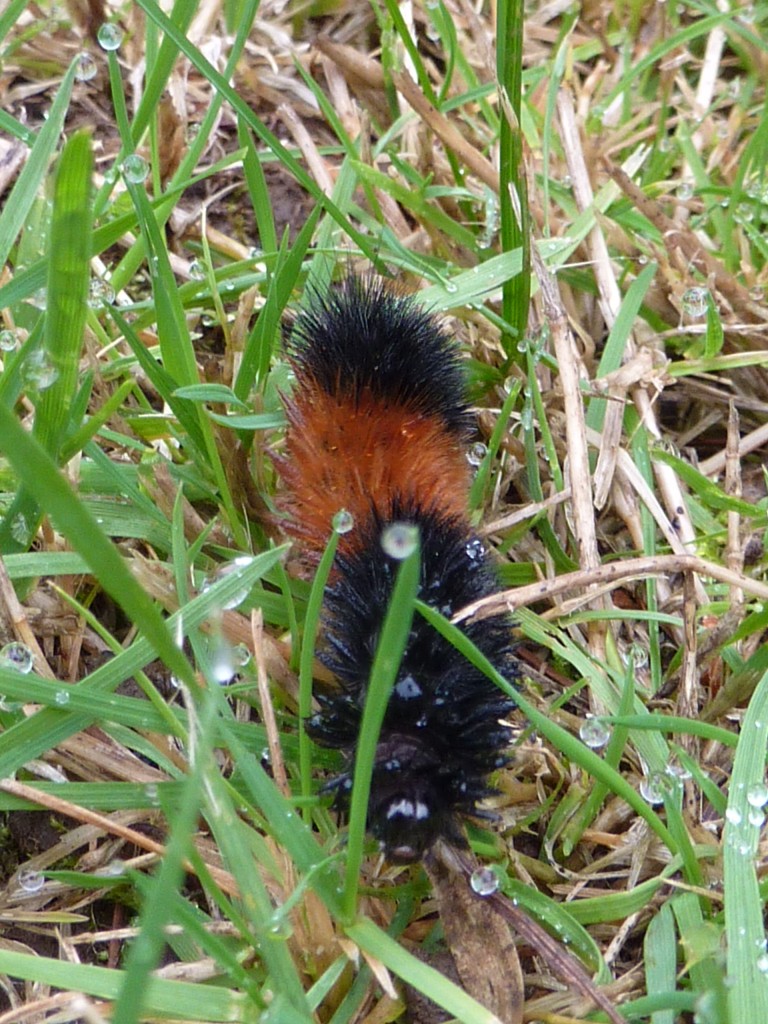MRS. TOMPKINS AND WOOLLY BEARS
I had driven up to Philomath to see my first grade teacher and neighbor Mrs. Tompkins before she passed away. She was in a deep sleep while I was there so I left without a goodbye or Thank You. I remembered her quite fondly as a teacher and unfortunately there aren’t many like her. I stayed the night at a friends house in Eddyville where I grew up and while we were sitting on her porch we shared memories of her over coffee, fresh air, surrounded by beautiful trees. I noticed a Woolly Bear…then another and another. The lawn was filled with hundreds of Woolly Bears searching for places to hibernate during the winter. Of course I had my trusty camera and started taking photographs. The phone rang and my friend ran inside to answer it. When she came back she had a grief stricken look on her face. Mrs. Tompkins son James had called with news his mother had passed away.
Being an avid reader of all positive religious teachings I have no fear of death I tend to believe in heavens and reincarnations. Hell only exists on earth and created by those whose hearts have invented a satan to whom they give power over God. Mrs. Tompkins was not the type to preach or succumb to hysteria she was kind to everyone and quick to offer a helping hand if needed. She shared what she grew in her garden as well as what was in her cupboards….and more importantly she shared the goodness in her heart. She did these things not in a sanctimonious way or to draw attention to herself. She did these things because it was part of her nature….she actually lived what others get paid to preach about. She lived a life of grace.
Mrs. Tompkins passed in the best possible way a mother can pass surrounded by her children in the time leading up to her final breaths.
I discover where giant butterflies burrow and dream.
Startle them.
They rise in unison, become the sky
by imagining rainbows.
They are shimmering power in the wet light in this valley they call
Beautiful.
– Joy Harjo
from the FARMERS ALMANAC
Do Woolly Bear Caterpillars Forecast Winter Weather?
According to legend, the wider that middle brown section is (i.e., the more brown segments there are), the milder the coming winter will be. Conversely, a narrow brown band is said to predict a harsh winter. But is it true?
- Between 1948 and 1956, Dr. Curran’s average brown-segment counts ranged from 5.3 to 5.6 out of the 13-segment total, meaning that the brown band took up more than a third of the woolly bear’s body. As those relatively high numbers suggested, the corresponding winters were milder than average.
- But Curran was under no scientific illusion: He knew that his data samples were small. Although the experiments popularized and, to some people, legitimized folklore, they were simply an excuse for having fun. Curran, his wife, and their group of friends escaped the city to see the foliage each fall, calling themselves The Original Society of the Friends of the Woolly Bear.
- Thirty years after the last meeting of Curran’s society, the woolly bear brown-segment counts and winter forecasts were resurrected by the nature museum at Bear Mountain State Park. The annual counts have continued, more or less tongue in cheek, since then.
- For the past 10 years, Banner Elk, North Carolina, has held an annual “Woolly Worm Festival” each October, highlighted by a caterpillar race. Retired mayor Charles Von Canon inspects the champion woolly bear and announces his winter forecast.
Most scientists discount the folklore of woolly bear predictions as just that, folklore. Says Ferguson from his office in Washington, “I’ve never taken the notion very seriously. You’d have to look at an awful lot of caterpillars in one place over a great many years in order to say there’s something to it.”
Mike Peters, an entomologist at the University of Massachusetts, doesn’t disagree, but he says there could, in fact, be a link between winter severity and the brown band of a woolly bear caterpillar. “There’s evidence,” he says, “that the number of brown hairs has to do with the age of the caterpillar—in other words, how late it got going in the spring. The [band] does say something about a heavy winter or an early spring. The only thing is . . . it’s telling you about the previous year.”



Leave a comment